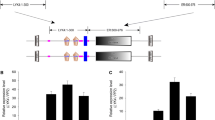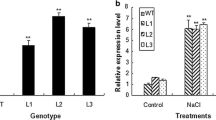Abstract
Plants have large families of proteins sharing a conserved eight-cysteine-motif (8CM) domain. The biological functions of these proteins are largely unknown. EARLI1 is a cold responsive Arabidopsis gene that encodes a hybrid proline-rich protein (HyPRP) with a three-domain architecture: a putative signal peptide at the N-terminus, a proline-rich domain (PRD) in the middle, and an 8CM domain at the C-terminus. We report here that yeast cells expressing different EARLI1 genes had significantly higher rates of freezing survival than empty-vector transformed controls. Arabidopsis plants with knocked down EARLI1 genes had an increased tendency for freezing-induced cellular damage. EARLI1-GFP fluorescence in transgenic plants and immunoblot analyses using protoplasts suggested cell wall localization for EARLI1 proteins. Immunoblot analyses showed that EARLI1 proteins form higher order complexes in plants, and that the PRD is a soluble and the 8CM an insoluble protein domain. We propose that EARLI1 proteins have a bimodular architecture in which the PRD may interact with the cell wall and the 8CM domain with the plasma membrane to protect the cells during freezing stress.








Similar content being viewed by others
Abbreviations
- 8CM:
-
Eight-cysteine-motif
- CaMV:
-
Cauliflower mosaic virus
- Col:
-
Columbia ecotype of Arabidopsis
- EL:
-
Electrolyte leakage
- EXT:
-
Extensin
- HyPRP:
-
Hybrid proline-rich protein
- LTP:
-
Lipid transfer protein
- β-ME:
-
β-Mercaptoethanol
- PRD:
-
Proline-rich domain
- PRP:
-
Proline-rich protein
- RNAi:
-
RNA interference
References
Blom N, Gammeltoft S, Brunak S (1999) Sequence- and structure-based prediction of eukaryotic protein phosphorylation sites. J Mol Biol 294:1351–1362
Bubier J, Schläppi M (2004) Cold induction of EARLI1, a putative Arabidopsis lipid transfer protein, is light and calcium dependent. Plant Cell Environ 27:929–936
Chen THH, Gusta LV, Fowler DB (1983) Freezing injury and root development in winter cereals. Plant Physiol 73:773–777
Danyluk J, Perron A, Houde M, Limin A, Fowler B, Benhamou N, Sarhan F (1998) Accumulation of an acidic dehydrin in the vicinity of the plasma membrane during cold acclimation of wheat. Plant Cell 10:623–638
Deutch CE, Winicov I (1995) Post-transcriptional regulation of a salt-inducible alfalfa gene encoding a putative chimeric proline-rich cell wall protein. Plant Mol Biol 27:411–418
Endo S, Demura T, Fukuda H (2001) Inhibition of proteasome activity by the TED4 protein in extracellular space: a novel mechanism for protection of living cells from injury caused by dying cells. Plant Cell Physiol 42:9–19
Gleave AP (1992) A versatile binary vector system with a T-DNA organisational structure conducive to efficient integration of cloned DNA into the plant genome. Plant Mol Biol 20:1203–1207
Goodwin W, Pallas JA, Jenkins GI (1996) Transcripts of a gene encoding a putative cell wall-plasma membrane linker protein are specifically cold-induced in Brassica napus. Plant Mol Biol 31:771–781
Hajdukiewicz P, Svab Z, Maliga P (1994) The small, versatile pPZP family of Agrobacterium binary vectors for plant transformation. Plant Mol Biol 25:989–994
Imai R, Chang L, Otha A, Bray EA, Takagi M (1996) A lea-class gene of tomato confers salt and freezing tolerance when expressed in Saccharomyces cerevisiae. Gene 170:243–248
Josè-Estanyol M, Gomis-Ruth FX, Puigdomenech P (2004) The eight-cysteine motif, a versatile structure in plant proteins. Plant Physiol Biochem 42:355–365
Kader J-C (1996) Lipid-transfer proteins in plants. Annu Rev Plant Physiol Plant Mol Biol 47:627–654
Karev GP, Wolf YI, Rzhetsky AY, Berezovskaya FS, Koonin EV (2002) Birth and death of protein domains: a simple model of evolution explains power law behavior. BMC Evol Biol 2:18
Lee I, Amasino RM (1995) Effect of vernalization, photoperiod, and light quality on the flowering phenotype of Arabidopsis plants containing the FRIGIDA gene. Plant Physiol 108:157–162
Murashige T, Skoog F (1962) A revised medium for rapid growth and bioassay with tobacco tissue cultures. Physiol Plant 15:473–497
Reeves PH, Coupland G (2000) Response of plant development to environment: control of flowering by daylength and temperature. Curr Opin Plant Biol 3:37–42
Richards KD, Gardner RC (1995) pEARLI1: an Arabidopsis member of a conserved gene family. Plant Physiol 109:1497
Sambrook J, Maniatis T, Fritsch EF (1989) Molecular cloning: a laboratory manual, 2nd edn. Cold Spring Harbor Press, Cold Spring Harbor, NY
Showalter MA (1993) Structure and function of plant cell wall proteins. Plant Cell 5:9–23
Uemura M, Tominaga Y, Nakagawara C, Shigematsu S, Minami A, Kawamura Y (2006) Responses of the plasma membrane to low temperatures. Physiol Plant 126:81–89
Veal EA, Ross SJ, Malakasi P, Peacock E, Morgan BA (2003) Ybp1 is required for the hydrogen peroxide-induced oxidation of the Yap1 transcription factor. J Biol Chem 278:30896–30904
Vogel JT, Zarka DG, Van Buskirk HA, Fowler SG, Thomashow MF (2005) Roles of the CBF2 and ZAT12 transcription factors in configuring the low temperature transcriptome of Arabidopsis. Plant J 41:195–211
von Arnim AG, Deng XW, Stacey MG (1998) Cloning vectors for the expression of green fluorescent protein fusion proteins in transgenic plants. Gene 221:35–43
Warren G, McKown R, Marin AL, Teutonico R (1996) Isolation of mutations affecting the development of freezing tolerance in Arabidopsis thaliana (L.) Heynh. Plant Physiol 111:1011–1019
Wei H, Dhanaraj AL, Arora R, Rowland LJ, Fu Y, Sun L (2006) Identification of cold acclimation-responsive rhododendron genes for lipid metabolism, membrane transport and lignin biosynthesis: importance of moderately abundant ESTs in genomic studies. Plant Cell Environ 29:558–570
Weiser RL, Wallner SJ, Waddell JW (1990) Cell wall and extensin mRNA changes during cold acclimation of pea seedlings. Plant Physiol 93:1021–1026
Wesley SV, Helliwell CA, Smith NA, Wang MB, Rouse DT, Liu Q, Gooding PS, Singh SP, Abbott D, Stoutjesdigk PA, Robinson SP, Gleave AP, Green AG, Waterhouse PM (2001) Construct design for efficient, effective and high-throughput gene silencing in plants. Plant J 27:581–590
Weyman PD, Pan Z, Feng Q, Gilchrist DG, Bostock RM (2006a) A circadian rhythm-regulated tomato gene is induced by arachidonic acid and Phythophthora infestans infection. Plant Physiol 140:235–248
Weyman PD, Pan Z, Feng Q, Gilchrist DG, Bostock RM (2006b) DEA1, a circadian- and cold-regulated tomato gene, protects yeast cells from freezing death. Plant Mol Biol 62:547–559
Whitham SA, Wang Y (2004) Roles for host factors in plant viral pathogenicity. Curr Opin Plant Biol 7:365–371
Wilkosz R, Schläppi M (2000) A gene expression screen identifies EARLI1 as a novel vernalization-responsive gene in Arabidopsis thaliana. Plant Mol Biol 44:777–787
Yamada T, Kuroda K, Jitsuyama Y, Takezawa D, Arakawa K, Fujikawa S (2002) Roles of the plasma membrane and the cell wall in the responses of plant cells to freezing. Planta 215:770–778
Zhang L, Ohta A, Takagi M, Imai R (2000) Expression of plant group 2 and group 3 lea genes in Saccharomyces cerevisiae revealed functional divergence among LEA proteins. J Biochem 127:611–616
Zhang JH, Jia WS, Yang JC, Ismail AM (2006) Role of ABA in integrating plant responses to drought and salt stresses. Field Crops Res 97:111–119
Acknowledgment
We are grateful to J. Anderson (Marquette University, Milwaukee, WI, USA) and members of his lab for help with yeast experiments; to J. Bubier and G. T. Hayman (Marquette University) for generating EARLI1 knockdown lines; to M. Nagao (Iwate University, Morioka, Japan) for help with the electrolyte leakage assays; and to Y. Pan (Marquette University) for protoplast preparation. The phosphorimager was provided by NSF Instrumentation grant No. D.B.I. 0100667. This research was supported by NRI Competitive Grant No. 2001-35100-10688 from the US Department of Agriculture.
Author information
Authors and Affiliations
Corresponding author
Rights and permissions
About this article
Cite this article
Zhang, Y., Schläppi, M. Cold responsive EARLI1 type HyPRPs improve freezing survival of yeast cells and form higher order complexes in plants. Planta 227, 233–243 (2007). https://doi.org/10.1007/s00425-007-0611-2
Received:
Accepted:
Published:
Issue Date:
DOI: https://doi.org/10.1007/s00425-007-0611-2




